 |
February 2014
|
February 2014 // Volume 52 // Number 1 // Tools of the Trade // v52-1tt9
Design Matters in Community Gardens
Abstract
With increased focus on local foods, food safety, nutrition, and physical health, community gardens are being created by a variety of entities, many of which are seeking assistance from Extension agents and specialists in the fields of horticulture, family consumer science, and 4-H. Extension professionals have expertise in nutrition, health, food safety, and food production, yet have little training in community garden design, which can provide the framework for successful gardens. Based on analysis of landscape elements of 10 professionally designed community gardens, recommendations were developed to help Extension professionals work with garden designers and volunteers.
Introduction
Community Gardens Defined
Community garden are green spaces where people garden together. They may be primarily ornamental or exclusively for food production while others are combinations. Community gardens are about planting ideas, growing skills, nurturing leadership and self-esteem (Voluntad, Dawson, & Corp, 2004). There are many different types, including temporary gardens on borrowed land, gardens that are in city parks and recreation departments, and gardens on land owned by gardeners.
A Case for Design
In a review of community garden literature, Guitart, Pickering, and Byrne (2012) summarized results from 87 academic papers, which revealed little information describing community garden design. Michael Buchenau, landscape architect and executive director of Denver Urban Gardens (DUG), has designed and helped establish many community gardens. He asserts that gardens ought to be considered part of the permanent urban landscape, like a park or as an outdoor space in which people engage in civic activity, and therefore need to be deliberately designed for such purposes. Designing for aesthetic experiences in community gardens helps connect individuals to spaces that promote healthy behaviors (Hale, 2012). Landscape architects and landscape designers can help facilitate social and educational factors by addressing issues like flow patterns, spatial dimensioning, program development, and design spaces that respond to stakeholder inputs (Buchenau, M. Interview conducted October 17, 2011; Johnson, 2005). The study reported here identifies design elements in 10 professionally designed community gardens in order to better understand design strategies, patterns, and landscape elements that lead to effective community gardens.
Methods
The 10 community gardens chosen for the evaluation range in size from about 0.18 acre to 1.84 acres, and represent suburban and urban sites (Figure 1). Included are general-purpose gardens and gardens that are shared with schools or universities. Each garden was designed by landscape architects experienced in community garden design. These gardens are well-established, like Danny Woo International District (est. 1975) and Bradner Gardens Park (est. 1987), and/or are part of established successful programs like the six gardens designed by the DUG program and three in Seattle's P-Patch program, that have aided in the development of many successful community gardens. The evaluation quantitatively examines the space allocation of landscape elements and qualitatively assesses the design patterns of the gardens, including form and spatial relationships. The designs for each of the gardens can be compared in Figure 1.
Figure 1.
Plans of 10 Community Gardens Shown at Same Scale
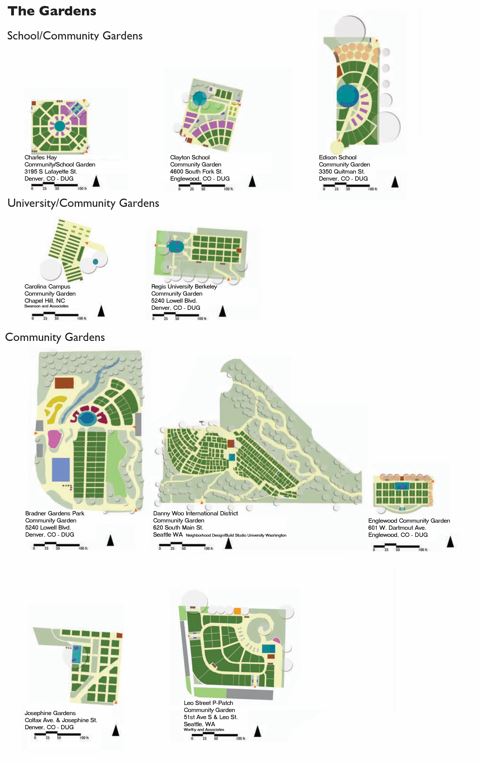
Landscape elements evaluated:
- Paths—accommodate pedestrian and equipment circulation
- Community Plots—managed by individuals or the group
- School Plots—used by school classes
- Accessible Plots—designed for ease of access to those with limited mobility
- Other Plantings—plantings other than plots, like flower gardens
- Donated/Named Gardens—can be demonstration gardens or welcome gardens within
- Fruit Trees—provide shade and food for people and wildlife
- Children's Gardens—specifically created for children to grow plants and play
- Children's Play Areas—non-gardening spaces for play equipment, and other non-garden activities
- Gathering Space Main and Secondary—open space used for social activities
- Lawn—space planted and maintained in mowed grass for multi-purpose uses
- Shade Structures—trees and manmade structures
- Seating - include tables, chairs, benches and picnic tables
- Sheds/buildings—provide storage, bathroom and meeting rooms
- Compost Areas—for managing organic matter; often in bins
- Parking—for vehicles
Design patterns, including both form and spatial relationships were also identified as follows.
Form
- Radial: curvilinear lines
- Grid: rectilinear geometries
- Radial/Grid: a combination
Spatial Relationships
- Proximity of elements to one another as seen in plans of gardens (Figures 2-11)
- Sun exposure
Results
The percentage of space allocated to each landscape element is quantified in Table 1. Most of the elements took roughly the same percentage (within 10%) of space in garden, with five exceptions. Community plots and paths were present in all gardens, but the amount of space allocated to each varied widely. Qualitative assessment informed conclusions about the design forms (Table 2 and Figures 2-11). Percentages of sun/shade are presented in Table 3.
| Landscape elements | Range of percentages | Averages |
| Paths | 24.6 to 66.0* | 34.9 |
| Community plots | 11.9 to 44.0* | 27.1 |
| School plots | 0.0 to 12.5* | 2.6 |
| Accessible plots | 0.0 to 2.4 | 0.3 |
| Other plantings | 0.0 to 55.7* | 22.5 |
| Donated/Named gardens | 0.0 to 0.2 | 0.2 |
| Fruit trees | 0.0 to 14.6* | 2.4 |
| Children's gardens | 0.0 to 1.2 | 0.1 |
| Children's play areas | 0.4 to 1.2 | 0.2 |
| Gathering space, Main | 0.3 to 8.6 | 3.3 |
| Gathering space, Secondary | 0.0 to 3.1 | 0.4 |
| Lawn | 0.0 to 9.8 | 2.0 |
| Seating | 0.1 to 1.5 | 0.7 |
| Sheds/buildings | 0.0 to 1.3 | 0.6 |
| Compost areas | 0.0 to 0.8 | 0.5 |
| Parking | 1.9 to 8.9 | 1.1 |
| *More than 10%difference between percentages of element in garden | ||
| Grid type | Number of gardens |
| Radial | 4 |
| Rectilinear | 4 |
| Radial and Rectilinear | 2 |
| Range | Average | |
| Shade from structures | 0.0 to 3.0 | 0.4 |
| Shade from trees | 5.3 to 44.0 | 21.8 |
| Sun | 53.0 to 94.7 | 77.7 |
Figure 2.
Plan of Charles Hay Community Garden
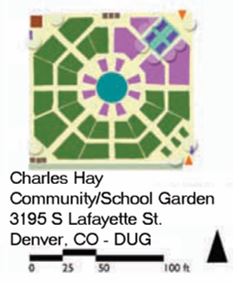
Figure 3.
Plan of Clayton School Community Garden
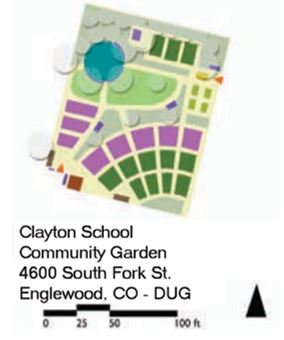
Figure 4.
Plan of Edison School Community Garden
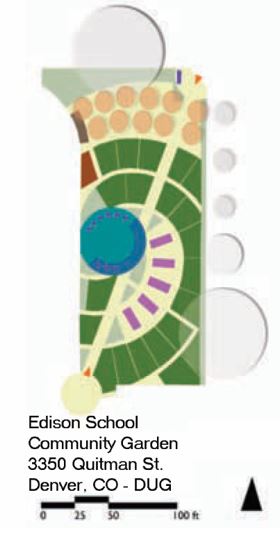
Figure 5.
Plan of Carolina Campus Community Garden
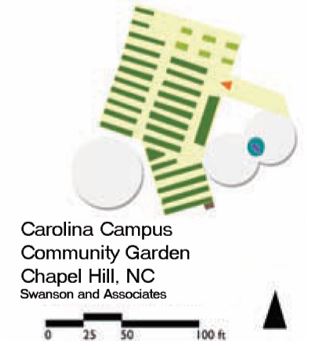
Figure 6.
Plan of Bradner Garden Park Community Garden
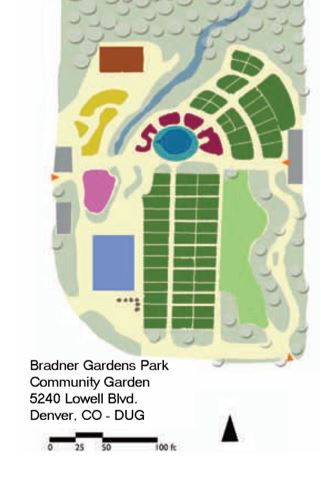
Figure 7.
Plan of Regis University Berkeley Community Garden

Figure 8.
Plan of Danny Woo International District Community Garden
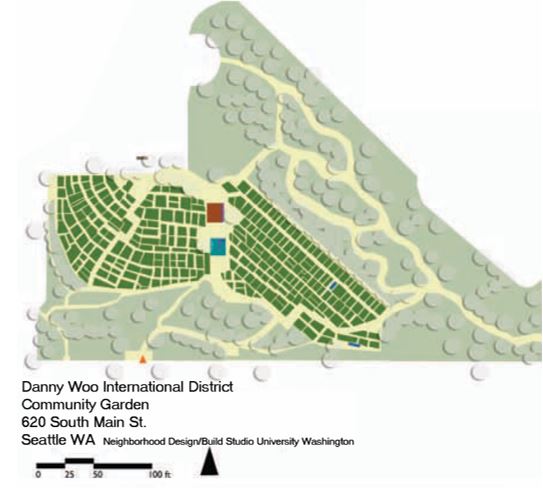
Figure 9.
Plan of Engelwood Community Garden
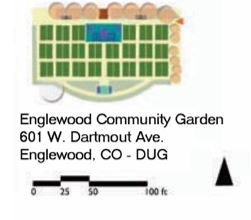
Figure 10.
Plan of Josephine Community Garden

Figure 11.
Plan of Leo Street P-Patch Community Garden

Conclusion
Design strategies identified herein serve as a support for the design of effective community gardens. Following is a summary of key lessons learned from this spatial evaluation. Space allocation varies among gardens depending on the purposes and stakeholder desires, making stakeholder input essential.
Paths, plots, plantings and play areas consistently use most of the space.
- Paths/circulation
- Rectilinear or radial grid patterns will vary based on user needs, and the site
- Include width for wheelbarrow use and traffic patterns
- Address handicap accessibility
- Community Plots
- Layout varies depending on site and needs
- Locate on southern side for full fun exposure
- School Plots
- Locate closest to the school for easy access
- Radial patterns are used as form
- Accessible Plots
- Locate near entrances for easy access
- Other Plantings
- Locate mostly on the northern side of the garden to minimize sun exposure impact on production plots and to create a buffer
- Donated/Named Gardens
- Locate in conspicuous areas
- Fruit Trees
- Locate on northern part of garden to minimize shading of production plots
- Children's Gardens and Children's Play areas
- Locate near the main gathering area for supervision
Critically located, small amounts of space accommodate social/cultural amenities.
- Gathering Space - Main and Secondary
- Locate under existing shade trees
- Include shade structure(s) where natural shade is unavailable
- Locate secondary gathering space opposite from the main gathering space
- Site centrally in northern part of garden
- Lawn
- Can serve as flexible gathering space or play area
- Locate near main gathering space
- Seating
- Locate in gathering spaces and in shade throughout the garden
- How much seating depends on community needs
- Sheds/buildings
- Locate on the edge of the garden, to maximize central space
- Consider multipurpose sheds that provide tool storage, covered meeting space, produce weighing and washing station, and more
- Shade Structures
- Locate on northern side of the garden to minimize unintentional shading of crops
- Compost Areas
- Locate on the edge of the garden
- Multiple compost areas add convenience and help distribute work load
- Parking
- Connect entrances with parking
References
Buchenau, M. (2011). A garden in every neighborhood. Retrieved from: http://dug.org/documentary
Guitart, D., Pickering, C., & Byrne, J. (2012). Past results and future directions in urban community gardens research, Urban Forestry & Urban Greening Journal, 11 364– 373
Hale, J., Knapp, C. Bardwell, L., Buchenau, M., Marshall, J. Sancar, F., & Litt, J. (2011). Connecting food environments and health through the relational nature of aesthetics: Gaining insight through the community gardening experience. Social Science & Medicine, 72 (11), 1853–1863
Johnson, L. (2005). Design for Food. Landscape Architecture, June, 30-34.
Voluntad, A., Dawson, P., Corp M. (2004). The Pendleton Community Garden Project—More than just planting seeds. Journal of Extension, 42(6) Article 6IAW2 Available at: http://www.joe.org/joe/2004december/iw2.php




